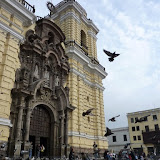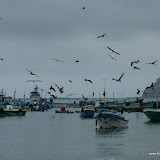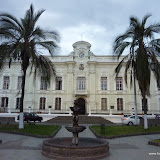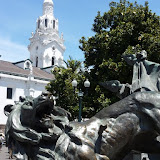At the heart of the Inca empire.
 At last, we got close to Peru's main jewel and new wonder of the world : the Machu Pichu.
At last, we got close to Peru's main jewel and new wonder of the world : the Machu Pichu.To get there, a stop in Cusco is mandatory. In old times, this city was the capital of the Inca empire (in quechua 'cusco' means navel, the Incas did found their capital where they thought the center of the word was located).
Nowadays, Cusco is a charming city of 'mestizo' (people with mixed spanish and indigenious blood) culture. It is full of magnificent colonial mansions, built over the outline of the old Inca city. Incas were experts in stone cutting and tying them up to create incredibly steady walls (I believe Tetris was invented by them centuries before its vulgarisation by Russians). Their cities were distributed into different squares around which they built houses and temples. When the Spanish conquered the city, they just used the existing constructions to build their houses and churches. That is why, in many of the houses of down-town Cusco, it is possible to see the original Inca walls, built over 500 years ago.
While visiting the area that surrounds Cusco, we were impressed with the level of development of the pre-Columbian civilisations. The Incas were warriors, and in the height of their empire, they had invaded a good part of South America. Originally they were not that much advanced, but on the other side, they took over the knowledge of the different cultures they have dominated. The archaeological and cultural richness of the area needs more than the few days we spend there. Inca people did master the techniques of weaving and dying tissues and the metallurgy of gold, silver, copper as wells as alloys. They had agrarian research centers and they did extract salt from a mountain source (still operated nowadays). They built trails that linked the different parts of the empire, scattered with rest areas and baths. They also diverted natural water courses not only to irrigate the terraces they spread all over the mountains but also to supply with water their 'nest-villages' built over the cliffs.
No wonder Peruvians are so pride of their Inca heritage. It does not feel as if at their arrival, the Spanish, right out of the obscure Midle Ages, were so much more advanced than their South American contemporaries.
Machu Pichu ruins are a beautiful example of what I call above a 'nest-village'. It is built over a steep mountain and its existence had been forgotten to be rediscovered in the early XXth century.
 Today, it is the main tourist attraction of Peru and probably of all South America. The Government, the railway company that holds the monopoly of accessing the village next to the ruins (there is no road, the other option is to walk for days on the mountains) and the bus company that takes you up to the site take advantage of it and go for the last dime in your pockets.
Today, it is the main tourist attraction of Peru and probably of all South America. The Government, the railway company that holds the monopoly of accessing the village next to the ruins (there is no road, the other option is to walk for days on the mountains) and the bus company that takes you up to the site take advantage of it and go for the last dime in your pockets.After a few stops to visit some interesting sites on our way up the Machu Pichu village, we spent a short night in our hotel. At 4:15 the next morning, we were queuing up to get into one of the first buses. The reason for this early wake-up call is accessing the site while the morning fog dissipates from the ruins and before the hordes of tourists arrives. As well, to get there among the first 400 people, that is the daily quota allowed to climb the adjacent mountain where, after a good number of Inca stone steps and some sweat, it is possible to enjoy the best views of Machu Pichu.
 Back in Cusco, and since I did not want to leave the place without trying the 'cuy' (guinea pig fried or roasted, a local dish), we went to one of the restaurants that offered it. We had the privilege to test the worst cooked and hardest 'cuy' ever… I am not sure if I lost one, or two, teeth trying to extricate some meat from the poor little thing. Maybe, we will be luckier in Bolivia, we will let you know if that is the case.
Back in Cusco, and since I did not want to leave the place without trying the 'cuy' (guinea pig fried or roasted, a local dish), we went to one of the restaurants that offered it. We had the privilege to test the worst cooked and hardest 'cuy' ever… I am not sure if I lost one, or two, teeth trying to extricate some meat from the poor little thing. Maybe, we will be luckier in Bolivia, we will let you know if that is the case.Bea


























